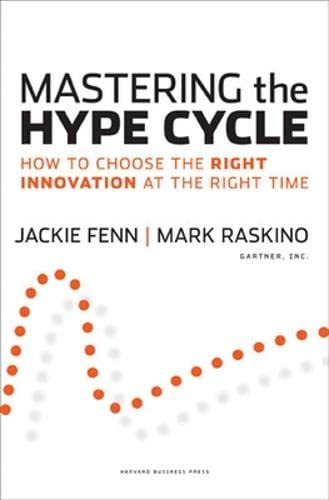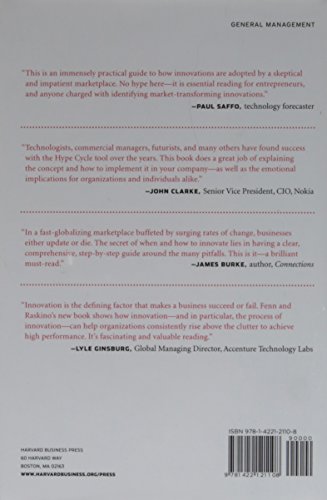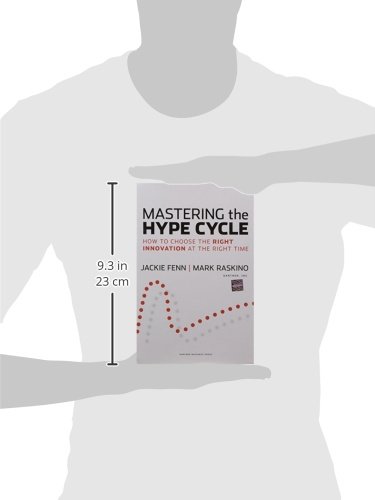



Mastering the Hype Cycle: How to Choose the Right Innovation at the Right Time (Gartner)
A**R
A must read
Applicable and insightful content for use across the spectrum of businesses.
F**I
Chart Basis, Pro’s and Con’s
Seeing mention of the hype cycle in Berinato’s Good Charts: The HBR Guide to Making Smarter, More Persuasive Data Visualizations , I recalled seeing examples during my consulting assignments where these diagrams and Gartner magic quadrants came into play. Struck anew by the parallels with technology adoption/change acceptance curves (see my review of Duarte’s Illuminate: Ignite Change Through Speeches, Stories, Ceremonies, and Symbols ), I became interested in looking at this book to further understand the hype cycle origins and meaning.Most drawn to this book will know that Gartner is a prominent research and advisory company started in 1979 that has expanded beyond its initial information technology focus to include other business functions. Co-authors Fenn and Raskino both still at Gartner, had been involved in devising the hype cycle chart and pioneering its use---a way to characterize a new technology or other innovation from its triggering and initial inflated expectations through the ‘trough of disillusionment’ and ‘’slope of enlightenment’ to adoption and ‘plateau of productivity’ (like other similar schemas such as described on page xiv and in Moore’s Crossing the Chasm, 3rd Edition (Collins Business Essentials) ---see my review). As suggested in the book’s extended title, executives and managers can (and often do) use these charts in helping make innovation investment and implementation decisions, making it worthy of attention in that regard.After their Preface, the authors proceed through 11 chapters: of narrative: (1) Hype Cycle Winners and Losers, (2) Behind the Hype Cycle, (3) Hype Cycle Traps and Challenges, (4) Hype Cycle Opportunities and Lessons, (5) What it Takes to Master the Hype Cycle, (6) Scope - Establishing the Context for Innovation, (7) Track - Collecting the Candidates, (8) Rank - Prioritizing Innovation Candidates, (9) Evaluate - Understanding Rewards and Risks, (10) Evangelize and Transfer - Making It Happen, and (11) Riding the Hype Cycle.My favorite parts include background and devising of the hype cycle, references to the Amish and their choices regarding technology use, and application of the STREET process (chapters 6-10) to monitor/evaluate innovations. In the first part of the book (on page 26), Fenn and Raskino relate the combination of ‘hype driven expectations’ and typical maturation to characterize human response to the new and novel in a storyline not unlike those discussed in Archer and Jockers’ The Bestseller Code: Anatomy of the Blockbuster Novel . The authors also describe a number of instances (pages 91-94) where different Amish groups have made determinations about the extent and how they will incorporate technology in ways that will help them preserve their cultures. In the second half of the book, they detail steps where observation and decision making applied in business that might be similarly adapted for use in dealing with broader cultural and social concerns as treated in Rose’s Confronting Technopoly: Charting a Course towards Human Survival (see my review).Gartner is still issuing hype cycle reports as I write and they continue to offer this means for trying to monitor what is coming in the way of new information technology and other related developments. So, it is well worth it to learn about their foundation as well as the pros and cons of their utilization.
R**Y
A (Slightly) Dated Book, but Still a Great Concept
Jackie Fenn's development of the "Hype Cycle" is certainly something that draws attention each year the updated cycle is published. This particular book, dated 2008, is now pretty "ancient" in technology terms, but the text explains the background and use of the Hype Cycle, and remains of great interest to anyone who is a technology watcher or has to make decisions of technology purchases for organizations. Because the annual Hype Cycle Report is quite expensive, this is a great entry point for anyone wishing to be introduced to the concept at a very low price.Fenn's Hype Cycle covers five phases of the technology life cycle:1. Technology Trigger2. Peak of Inflated Expectations3. Trough of Disillusionment4. Slope of Enlightenment5. Plateau of ProductivityThe cycle is depicted as a graphical equation upon which the various technologies are placed to categorize them into each of these five stages. In spite of the criticisms present on any such technology representation, the Hype Cycle is a convenient way to map technologies over time and to gain a sense of where each resides within its own life cycle.Highly recommended for any technologist.
V**R
a quick intro
This is a v.good summary. For those with a background in innovation it's a quick scan. For those new to the area, it's a basic intro to a tool that the Gartner group has been refining. While it is self contained, it points to their web site, particularly for examples outside of emerging technologies. While the volume hints at it, the authors do not really explain the real depth and work needed to really fill out a proper analysis which is then back cast into the model. Unless the enterprise, be it gov't, non profit or corp has the fiscal and mgmt resources, one needs to decide where in the cycle to play from innovator to late adopters. Missing is a strong discussion of "scale", both of the height of the HYPE and the time scales, and whether there are discontinuities and non-linearities which impact on the analysis. Given our understanding of complex systems, the authors need to transcend their current model which, today is a weakened but basic metaphor.
C**E
Decent content delivered rather poorly
It is useful. A lot of people talk about the hype cycle without fully understanding its implications, how to interpret it, or how to take action based in the information it conveys. This book helps overcoming shallow, futile and misguided talk. However, it can be tedious to read, since it sometimes has an overdose of lengthy "real world" examples. It is ok to briefly exemplify an idea for the sake of clarity, but when it interrupts the explanation of concepts, it actually becomes an obstacle. Besides this, the Hype Cycle is a product by Gartner. That is totally respectable, and I think it is a great contribution by Gartner. Nevertheless the selling discourse is sometimes rather obvious throughout the book, which can become annoying.Decent content, but failed in delivery. It is not a waste of time, but it is unnecesarily unpleasant.
M**N
Not worth a book - worth a chapter
The framework is a variation of the S curve, with a hype spike towards the beginning. But that's about it. How they manage to fill over 200 pages worth of writing is credit to Gartner analysts. They can write. Most of it is repetitive once you have read the 5 pages describing the cycle. I bought the book expecting examples of the cycle applied to various industries, technologies, perhaps even geographies. Nothing. I guess you need to subscribe to Gartner research for that.
F**O
Four Stars
Exelent
K**.
Mastering the Hype
Informative read of the basics
K**S
理解はできるが実践は!?
ハイプサイクルの詳細が事例をとおして懇切丁寧に説明されています。イノベーションに興味がある方には参考になると思います。サイクルの適応方法であるSTREETプロセスもわかりやすく紹介されていますが、これを全部ズブの素人がやるのかと思うほど、やや複雑か。ただ、このハイプサイクルのフレームワークを知っておけば、今テクノロジーの動きがどのあたりにいるのか、次はどういう動きになるのかといった投資のための仮説は立てやすくなるのも事実。その仮説を立てる際に、本書の必要なページをパラパラと読んでみるのが使い方として有効だと思います。テクノロジー導入がビジネスの左右を決める今日この頃、テクノロジー導入時期を考えている経営者やマネジャー層は読んでおいても損はないかと。
S**E
A "Must read" for those interested in Innovation
Most people working in the IT industry will have come across the Hype cycle in one form or another - if the "trough of disillusionment" rings a bell, then you have come across the Hype cycle.The book is split into two parts: Part One provides an overview of the Hype cycle. It takes us through each phase of the Hype cycle describing the characteristics of each phase. The (particularly) up to date examples help add life to the narrative. For me, I spent some time trying to work out where I thought many current innovations were in their journey through the Hype cycle - this is not as easy a task as you might think! However, it can be crucial to the success implementation of any innovation.Part Two describes a process (termed STREET by the authors) for identifying, tracking and then introducing innovations based on the Hype cycle and your organisation's drivers and appetite for risk. This part of the book takes us through the process, step by step.I think this book will be particularly useful to those people who are working in organisations that are involved in decisions about introducing new innovations. While it is aimed primarily at external innovations, there is no reason why the same process could not be applied to innovations that are generated from WITHIN your organisation.Well written (which is exactly what you would expect from two Gartner analysts!) and exceptionally useful. Practical and definitely not overly theoretical. It certainly made me stop and think a little more deeply about the innovations that I am involved with and how (and when) they should be pursued. Highly recommended reading.
C**N
Viele Beispiele
Das wohl einzige Buch, das es derzeit zum Thema Hype Cycle gibt, welches auch noch von den Erfindern dieses Modells persönlich verfasst wurde.Deutlich im Vordergrund scheinen hier eindeutig die Beispiele zu stehen. Bereits das Vorwort besteht zum größten Teil aus einem großen und einigen kleineren Beispielen. Auch Kapitel 1, "Hype Cycle Winners ans Losers", wird mit einem umfangreichen Beispiel eröffnet und anschließend jede Theorie mit einem Beispiel untermauert. Dies schafft eine gewisse Anschaulichkeit für das doch recht komplexe Thema des Hype Cycle.
N**R
Très bon ouvrage mais il manque un état de l'art des autres Cycles de l'innovation
Ce livre est très intéressant et vaut le coup d'être consulté. En revanche, j'aurai apprécié qu'il soit plus critique envers son point de vue pour permettre au lecteur de mieux se positionner face à l'outil proposé.Je suis très satisfait par cet achat.
P**A
The exec summary would have been better
It seems like there is a great small book on the hype cycle hidden in this tome on the subject. Good context but lots of fluff.
Trustpilot
1 month ago
2 weeks ago